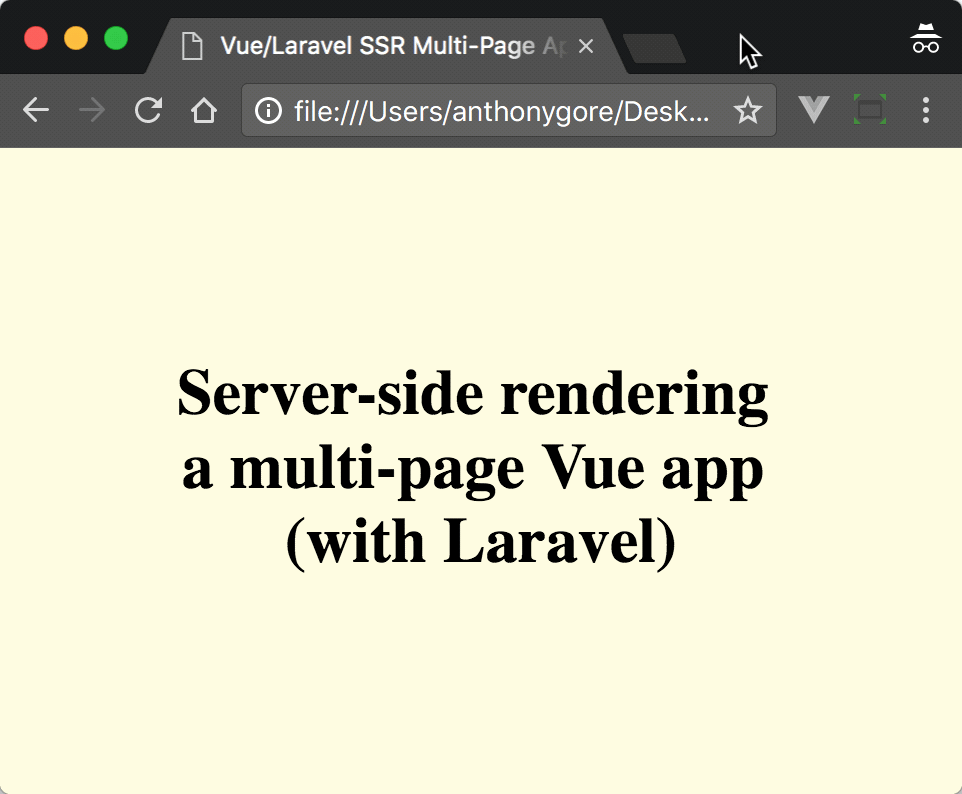Advanced Server-Side Rendering With Laravel & Vue

Now I want to build on that previous tutorial and demonstrate how to server render a Vue app that includes multiple pages with Vue Router, since most of your Laravel projects will have more than one page.

You can get the completed code for this tutorial here on Github.
Note: this article was originally posted here on the Vue.js Developers blog on 2017/11/27
Installation
This tutorial will extend the app I built in the previous article, Server-Side Rendering With Laravel & Vue.js 2.5. Make sure you’re familiar with how it works and have a suitable development environment set up i.e. with the php-v8js extension installed.
If you don’t have that code, clone it and set it up:
$ git clone https://github.com/anthonygore/vue-js-laravel-ssr
$ cd vue-js-laravel-ssr
$ cp .env.example .env
$ composer install
$ npm i
Then install Vue Router:
$ npm i --save-dev vue-router
Router module
We’ll begin by creating a file for our router configuration that exports an instance of the router for use in the app.
I’ve made up some sample routes with each displaying a component generated from the method pageComponent. This factory method returns a simple component that does nothing more than display the name of the page. This is all we need to prove SSR routing works.
resources/assets/js/router.js
import Vue from 'vue'
import Router from 'vue-router'
Vue.use(Router);
function PageComponent(name) {
return {
render: h => h('h3', `Hello from the ${name} page`)
};
}
export default new Router({
mode: 'history',
routes: [
{ path: '/', component: PageComponent('Home'), name: 'home' },
{ path: '/about', component: PageComponent('About'), name: 'about' },
{ path: '/contact', component: PageComponent('Contact'), name: 'contact' }
]
});
router.js
In the main app file we’ll now import the router module and add it to the app, just as you would in any Vue project. The app instance is then exported for use in the client and server entry files.
resources/assets/js/app.js
import App from './components/App.vue';
import Vue from 'vue';
import router from './router'
export default new Vue({
router,
render: h => h(App)
});
app.js
Laravel routes
Note that our Vue Router instance is in history mode, so routes will fallback to the server when a sub-page is refreshed or loaded from the navigation bar.
This means that any route that we created in the front-end app also needs to be created on the server side. They can all point to the same controller method get:
routes/web.php
<?php
Route::get('/', 'AppController@get');
Route::get('/about', 'AppController@get');
Route::get('/contact', 'AppController@get');
web.php
Controller
Now we need to set up multi-page SSR in the controller. This is a modification of the logic in the base app, so make sure you’re familiar with how that worked.
To SSR a multi-page app, we need to tell the Vue server app (as defined in entry-server.js) what the current URL being requested is. This will ensure that when the app loads in the sandbox, it’s displaying the correct page component.
To do this we pass the URL i.e. $request->path() through to the render method from the get method. We then store the URL in a global JavaScript variable url that will be accessible from the Vue server app when it runs in the sandbox.
app/Http/Controllers/AppController.php
<?php
namespace App\Http\Controllers;
use Illuminate\Http\Request;
use Illuminate\Support\Facades\File;
use Illuminate\Routing\Route;
class AppController extends Controller
{
private function render($path) {
$renderer_source = File::get(base_path('node_modules/vue-server-renderer/basic.js'));
$app_source = File::get(public_path('js/entry-server.js'));
$v8 = new \V8Js();
ob_start();
$js =
<<<EOT
var process = { env: { VUE_ENV: "server", NODE_ENV: "production" } };
this.global = { process: process };
var url = "$path";
EOT;
$v8->executeString($js);
$v8->executeString($renderer_source);
$v8->executeString($app_source);
return ob_get_clean();
}
public function get(Request $request) {
$ssr = $this->render($request->path());
return view('app', ['ssr' => $ssr]);
}
}
AppController.php
Vue server app
The last major step is to modify the Vue server app so that we can programmatically set the URL rather than waiting for a user to do it.
The logic for doing this is inside the Promise callback function. Here’s what it does:
- The router is set to the correct URL by pushing the global variable
url - When the router is ready, we see if any page components are being displayed as a result of this push, telling us the route is valid. If not, we throw a 404. If so, we return the app instance.
A Promise is used because the router loads asynchronously. Once this Promise resolves, we can use the server renderer method renderVueComponentToString to SSR the instance and finally use print to return the output back to our Laravel environment.
resources/assets/js/entry-server.js
import app from './app'
import router from './router';
new Promise((resolve, reject) => {
router.push(url);
router.onReady(() => {
const matchedComponents = router.getMatchedComponents();
if (!matchedComponents.length) {
return reject({ code: 404 });
}
resolve(app);
}, reject);
})
.then(app => {
renderVueComponentToString(app, (err, res) => {
print(res);
});
})
.catch((err) => {
print(err);
});
entry-server.js
App file
The SSR logic for the multi-page app is now complete. Let’s create some router links in the page so we can test the app in a browser:
resources/asset/js/components/App.vue
<template>
<div id="app">
<h1>{{ title }}</h1>
<router-view></router-view>
<router-link :to="{ name: 'about' }">About</router-link>
<router-link :to="{ name: 'contact' }">Contact</router-link>
</div>
</template>
<script>
export default {
data() {
return {
title: 'Welcome To My Site'
}
}
}
</script>
app.vue
Loading the home page look like this:

The real test is visiting a route in the navigation bar so the server routes handle the request and hopefully SSR the app. To do so, visit http://localhost:9000/about and inspect the source markup. As you can see, it includes the rendered app at the correct URL:

Recommended Courses:
☞ Vuejs 2 + Vuex con TypeScript Nivel PRO
☞ Curso de Vuejs 2, Cognito y GraphQL
☞ Learn VueJS from Scratch: The Complete 1 Hour Crash Course!
☞ SSR con Vuejs, Vuex y Quasar Framework
Suggest:
☞ Learn GraphQL with Laravel and Vue.js - Full Tutorial
☞ Vue js Tutorial Zero to Hero || Brief Overview about Vue.js || Learn VueJS 2023 || JS Framework
☞ Laravel Tutorial - Abusing Laravel